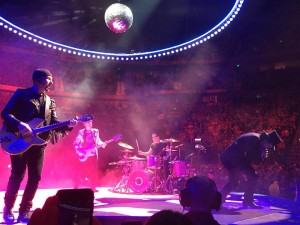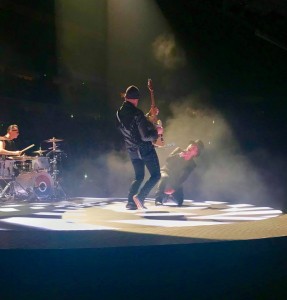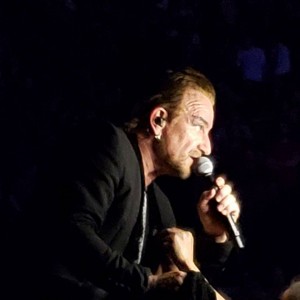From Invocation to Benediction: Tennessee Sings Along to U2’s Stories of Experience and Innocence
May 31, 2018 · Print This Article
Here in the so-called “Buckle of the Bible Belt,” home to around 540 churches and the main offices of major denominations but also to dive bars and honky tonks, Nashville is a study in contrasts. Houses of worship are so ubiquitous that when the Bridgestone Arena was built, the Metro Council had to grant an exemption to the ordinance regulating how far an establishment had to be from a church in order to sell alcohol.
Just outside from the Arena there lies another string of hallowed halls. From Tootsies to Robert’s Western World to Ernest Tubb’s Record Shop, Nashville’s secular temples are graced by the pantheon of country music deities singing songs of heartache, the hardscrabble lives of the rural poor both white and black, and the wicked mistress of whiskey. Across Broadway from the Bridgestone is the Ryman Auditorium, the site of the original Grand Ole Opry Radio Show; while the hockey arena may be the bigger venue, there is only one “Mother Church,” the Ryman.
When Bono raps sentimental about the short distance between Saturday night and Sunday morning, he is thinking about places like Nashville. On weekends, partiers and the dreamers descend onto lower Broadway and their late Saturdays bleed into the early morning dawn of Sunday. Then, the many churches will open their doors in hopes that a few bleary-eyed prodigals may stumble upon them.
Like many former Western territories of the early days of the nation, Tennessee is shaped by the legacy of camp meetings where itinerant preachers would come to frontier areas to preach, pray, and lead hymns. People from surrounding areas would come to the site of the meeting to camp-out and engage in the temporary community at sunset, where the darkness of the temporal would be visited by glimpses of the light perpetual. The cultural purchase once held by these regular Southern summer events have long since given way. They are in many ways the precursors of the cultural event that has taken their place, the rock concert.
Into this liminal space where the boundaries of secular and sacred collide and collapse, enter the Irish rock itinerant teachers of the musical message. U2 descended upon Music City for a night of hard-charging rock n roll, unafraid and unabashed in its explorations of the ecstatic, religious, or otherwise. Like the schizophrenia embodied in the family tree that holds both the Pentecostal snake charmer of an evangelist, Jimmy Swaggart and his cousin Jerry Lee Lewis, “rock n roll’s first great wild man,” U2’s showman careened back and forth, embodying both the sawdust of the revival tent and the beer-soaked pianos of the honky tonks.
Early in the set, Bono invited the intimate gathering of 18,500 to walk with the band on a “boy’s journey” from innocence through experience. In light of the last two albums (Songs of Innocence and Songs of Experience), we have a glimpse of where walking with the band on this journey might take us. The last two albums borrow their titles from collections of poems by William Blake, where innocence and experience themselves are already refigurations of Milton’s mythic accounts of paradise and the fall. In this primal narrative and on this late Saturday in May, the band invited those gathered to consider how and what this childhood narrative that begins in Ireland with trauma and loss (and with discovered purpose) might also mean for those gathered together that night in (and for) America, a nation as divided and cynical as it has been at any point for the last 150+ years. Perhaps together, Bono hints, “At the far end of experience, with some wisdom and good company, he (we) can recover his (our) innocence.”
While few gathered in that arena were experts in English Romantic Poets like Blake or with the intricacies of the religious and socio-political environment of Ireland during and in the aftermath of The Troubles, we still get it. Our familiarity with the Southern gospel evangelists and the dramatic effect of the “personal testimony”– this common religious imagery of everyone’s rise and fall– provided a foothold for the band to invite us beyond our disappointment and cynicism into a transformed vision. This is the key to the power of this show and the band’s latest album.
What happens after the fall? When our hopes for harmony are dashed? When our falls and failures, large and small, awaken us to our own darkness and weakness? Can we risk belief again without succumbing to magical thinking? Can we accept loss and defeat and our own finitude without crippling despair and proclaim that this is “no time not to be (fully) alive”?
The concert leans heavily on the band’s latest record, Songs of Experience, with songs from the album bracketing the rest of the set, roughly divided to open and close the show as invocation and benediction. Themes of darkness and light run rife through the album and define the show, both in song selection from the greater U2 catalogue, as well as the stunning video display and visual props. The show opens with images of an MRI brain image and vocal instructions to breathe in and exhale. The scan itself (and Bono’s elusive hints at a brush with mortality) raises intriguing questions. But looking back on the whole concert experience, we now see these breathing instructions and startling images as a corporate invitation to enter into our own personal fragility and collective interior, where darkness and mystery exist even as we face illumination.
The grand power of the second act took us into the depths of darkness both personal and collective, without providing an easily demarcated boundary between them. Earlier in the show, U2 refigures the militant call to arms of Sunday Bloody Sunday as a mournful dirge, a concession and confession that the forces of darkness are not always vanquished by the sheer force of will and passion. Before an acoustic version of Staring at the Sun, Bono reminded us that the song might be about a form of willful blindness, the kind that can destroy a nation.
Without warning, the song is accompanied by the ugly images of raw racism and xenophobia in Charlottesville and throughout the country. By the time the giant screen that runs the length of the GA area displays the two large Confederate flags waving in slow motion, the visual gut punch is followed by the lyrics’ uppercut. We find that we’re not the only ones staring at the sun, afraid of what we’d find if we took a look inside. Somewhere in this late Southern Saturday night, I can somehow hear the faint sounds of a gospel choir warming up for Sunday morning: “It’s not my brother or my sister, but me, Oh Lord, standing in the need of prayer.” Truly, middle Tennessee needs this kind of purge and prayer, no matter how difficult it is to face our demons.
As Staring at the Sun gave way to Pride and the images onscreen transitioned to civil rights marches and Black Lives Matter, it is painfully clear that those gathered (overwhelmingly white and middle-to-upper-middle-class) more closely resemble the faces shown during the previous song, rather than the latter. Will we heed the voice of a James Baldwin when he reminds us that “People who shut their eyes to reality simply invite their own destruction, and anyone who insists on remaining in a state of innocence long after that innocence is dead turns himself into a monster.” We too often find ourselves as “acrobats” who talk like this, but act like that. A moment of decision is before us. Knowing what we know from this journey of experience, can resistance be mounted and innocence be re-discovered?
On first listen to the album, I thought that the opening chords of Get Out of Your Own Way sounded like the opening of Beautiful Day, but it’s placement in the setlist, leading us toward the climax of the concert is a herald that a new dawn may be possible, despite the lack of guarantees. Kendrick Lamar’s presence on American Soul offers a peek at what might be meant by gaining wisdom and good company, as we examine the play of darkness and light in ourselves, opening up to honest communion with voices and experiences that might indict our complicity.
Like the narrative arc of the revival, we have been brought to the moment of spiritual decision, but the invitation is not given with any guarantees, no quick fixes or tickets to exit (and thus) ignore this world. Instead, the band has led us from innocence through experience, only to ask us if we can risk the hope of innocence again. This risk is a way of reading our lives in and through the messiness of experience—and through its ambiguities, losses, and failures—making a wage of faith beyond faith, without guarantee or, many days, without any rational justification for it.
The closing trio of One (Invisible snippet), Love is Bigger Than Anything in Its Way and 13(There is a Light), this sequence is one of the more subdued ends to a U2 show I have ever experienced, and because of that, and not in spite of it, it may be one of the most impactful. Before singing 13, we are reminded that this is a prayer for our children, both biological and for the larger village of youth who go on before and after us. Our own journeys have limits and calls to let go.
As Bono works his way meditatively down the catwalk to reveal and release the single bulb hidden inside the miniature replica of his Cedarwood house, we see that the grand gesture of love often seems humble and small. It is a less dramatic gesture than when he would leave the baby spotlight illuminating the arena ceilings during 40 when they closed the 1987 Joshua Tree shows, but it is no less impactful. We’re on the other side of the desert now populated by Joshua Trees and far past the searing heat of experience and doubt. We can’t go back to that time or gesture, but this show does not leave us despairing. There is too much we can’t deny. There is a darkness, both within and without. But there is a light; don’t let it go out.
Without relinquishing their respective hallowed status, but for one Saturday evening in Nashville, the Mother Church, the honky tonks, and the numerous houses of worship, these icons gave space for a revelation to occur under the tent-like roof of Bridgestone Arena. And a diminutive Irish showman, who makes up in sheer bravado what he might lack in height, this Bono and his merry band from the north side of Dublin, they invited us to the sacred places that emerge when we carry each other, despite our differences and disagreements. The promises and calls may sound like the showman is lying for a living and letting on. And, yet, it somehow—in humble, yet powerful ways—it is somehow made true when we all sing along. And we did. – Rick Quinn, Contributing Editor @apophatic1
Special thanks to Torrey Viger, Colleen Grattan, & Jeff Koss for the Nashville pictures!







Comments
Got something to say?
You must be logged in to post a comment.